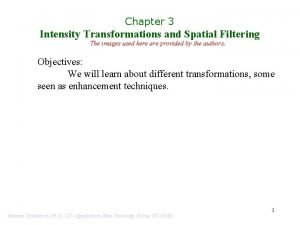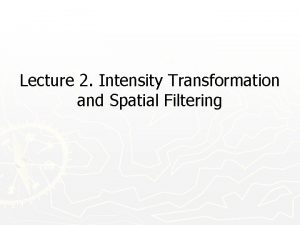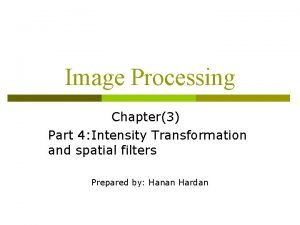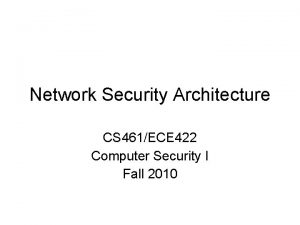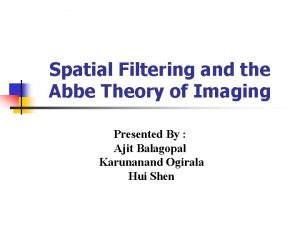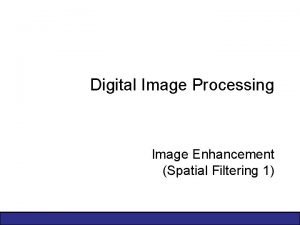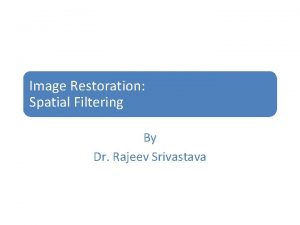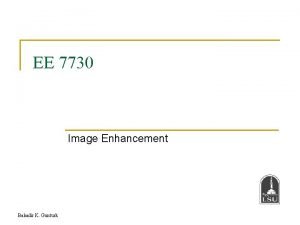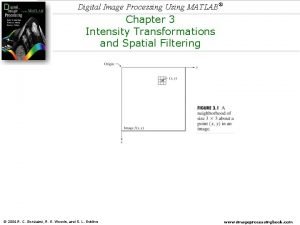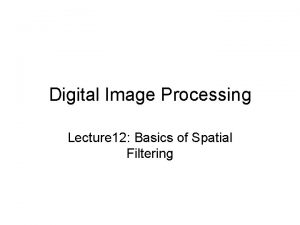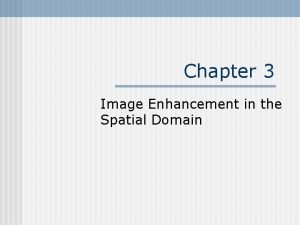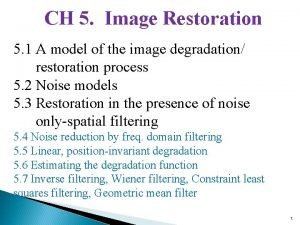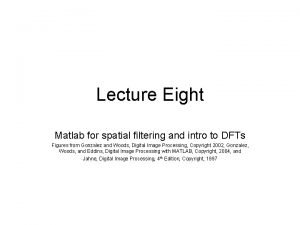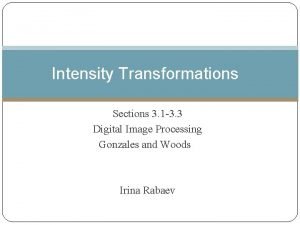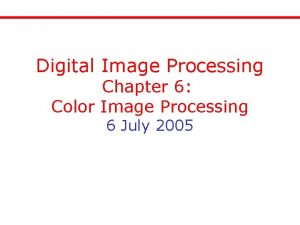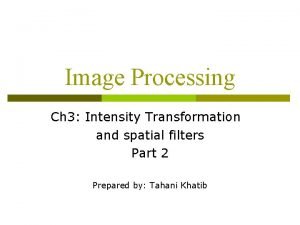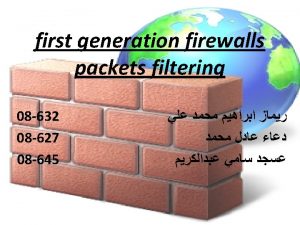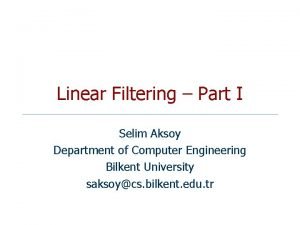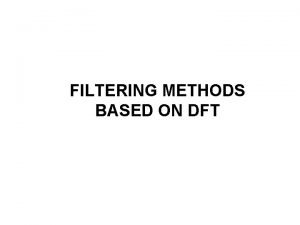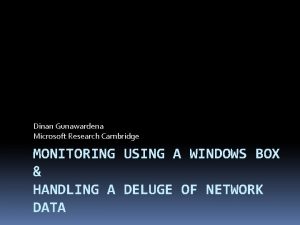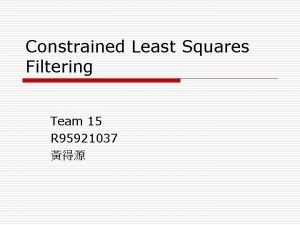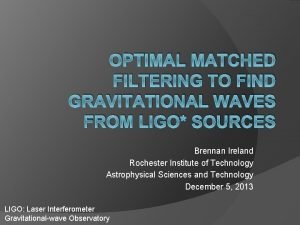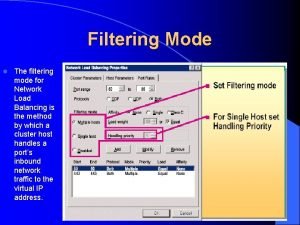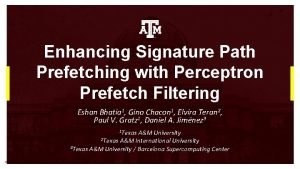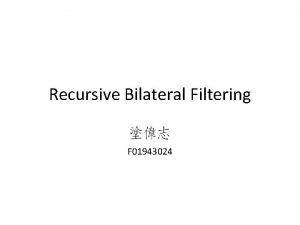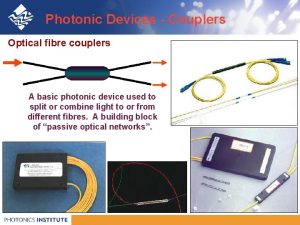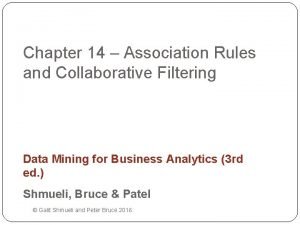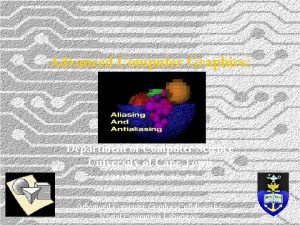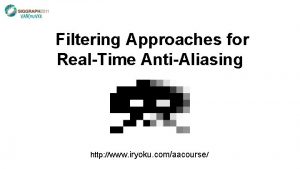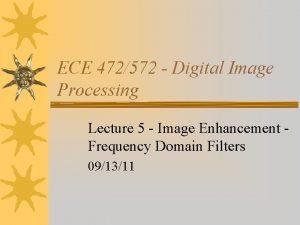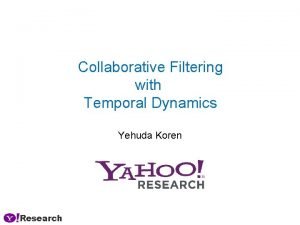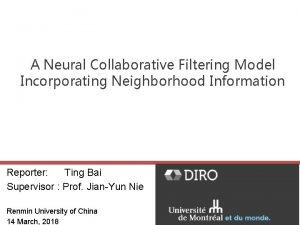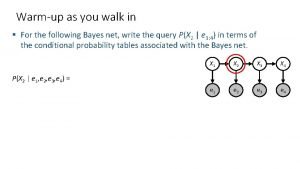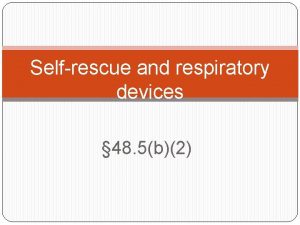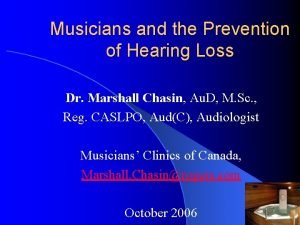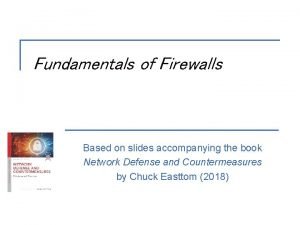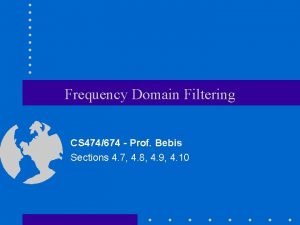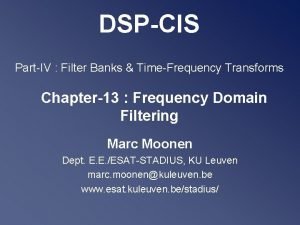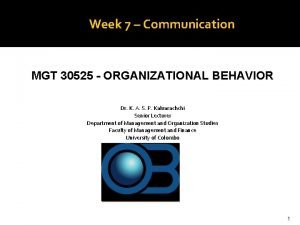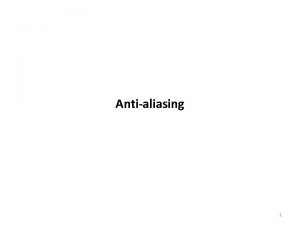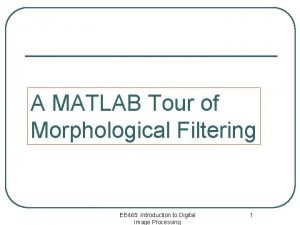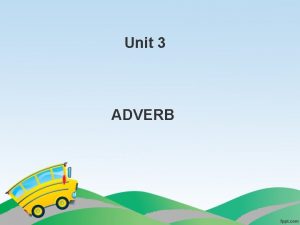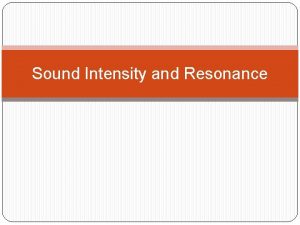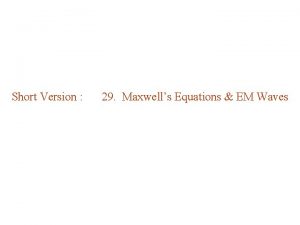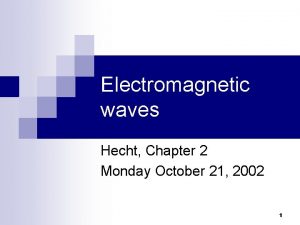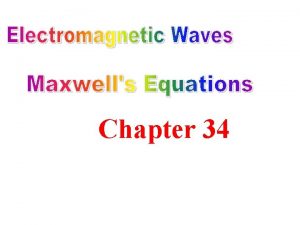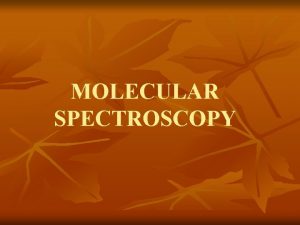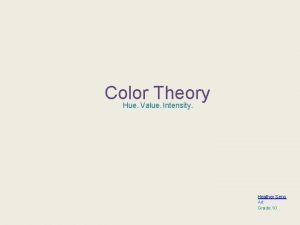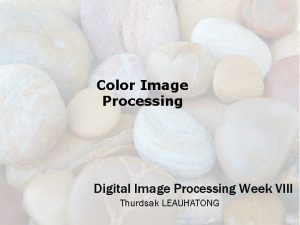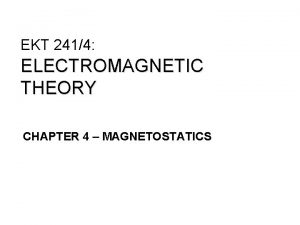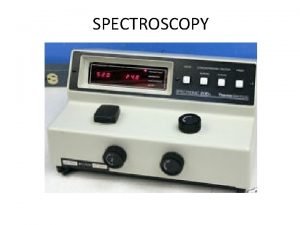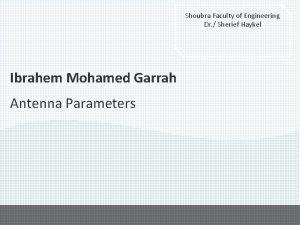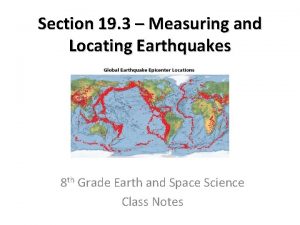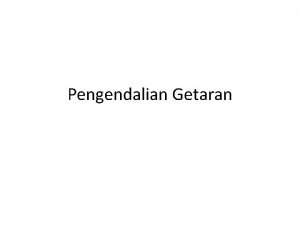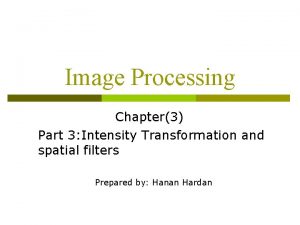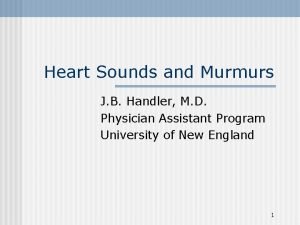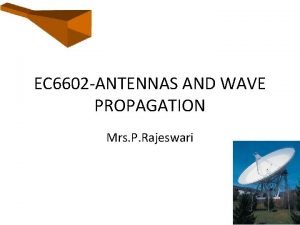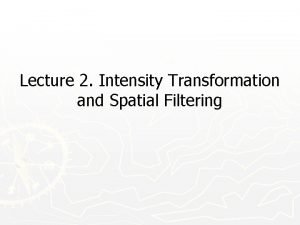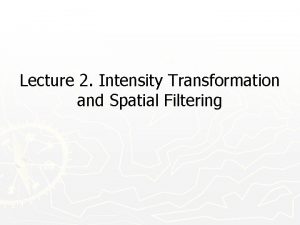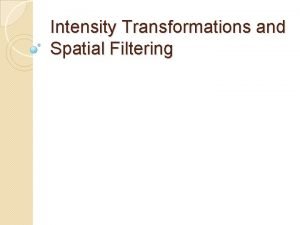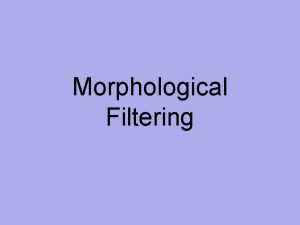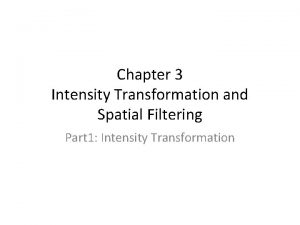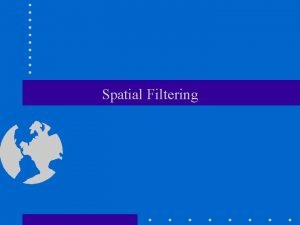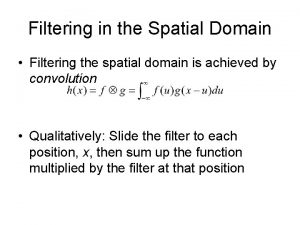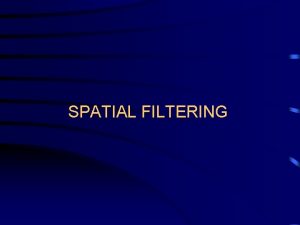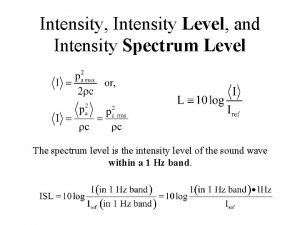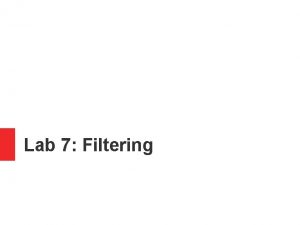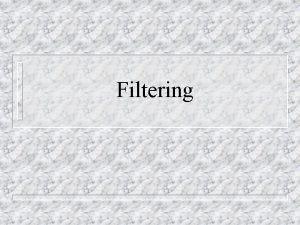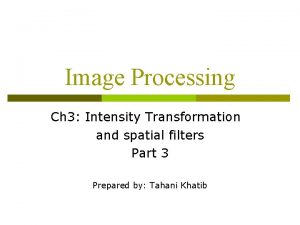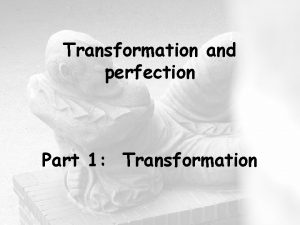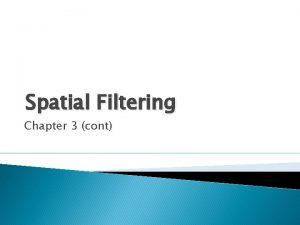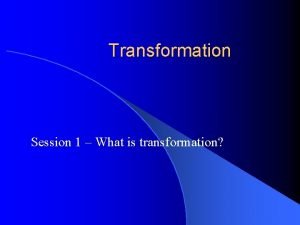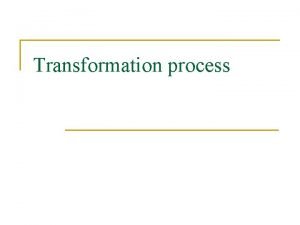Lecture 2 Intensity Transformation and Spatial Filtering Spatial

































































































- Slides: 97

Lecture 2. Intensity Transformation and Spatial Filtering

Spatial Domain vs. Transform Domain ► Spatial domain image plane itself, directly process the intensity values of the image plane ► Transform domain process the transform coefficients, not directly process the intensity values of the image plane 11/29/2020 2

Spatial Domain Process 11/29/2020 3

Spatial Domain Process 11/29/2020 4

Spatial Domain Process 11/29/2020 5

Some Basic Intensity Transformation Functions 11/29/2020 6

Image Negatives 11/29/2020 7

Example: Image Negatives Small lesion 11/29/2020 8

Log Transformations 11/29/2020 9

Example: Log Transformations 11/29/2020 10

Power-Law (Gamma) Transformations 11/29/2020 11

Example: Gamma Transformations 11/29/2020 12

Example: Gamma Transformations Cathode ray tube (CRT) devices have an intensity-to-voltage response that is a power function, with exponents varying from approximately 1. 8 to 2. 5 11/29/2020 13

Example: Gamma Transformations 11/29/2020 14

Example: Gamma Transformations 11/29/2020 15

Piecewise-Linear Transformations ► Contrast Stretching — Expands the range of intensity levels in an image so that it spans the full intensity range of the recording medium or display device. ► Intensity-level Slicing — Highlighting a specific range of intensities in an image often is of interest. 11/29/2020 16

11/29/2020 17

Highlight the major blood vessels and study the shape of the flow of the contrast medium (to detect blockages, etc. ) 11/29/2020 Measuring the actual flow of the contrast medium as a function of time in a series of images 18

Bit-plane Slicing 11/29/2020 19

Bit-plane Slicing 11/29/2020 20

Bit-plane Slicing 11/29/2020 21

Histogram Processing ► Histogram Equalization ► Histogram Matching ► Local Histogram Processing ► Using Histogram Statistics for Image Enhancement 11/29/2020 22

Histogram Processing 11/29/2020 23

11/29/2020 24

Histogram Equalization 11/29/2020 25

Histogram Equalization 11/29/2020 26

Histogram Equalization 11/29/2020 27

Histogram Equalization 11/29/2020 28

Example 11/29/2020 29

Example 11/29/2020 30

Histogram Equalization 11/29/2020 31

Example: Histogram Equalization Suppose that a 3 -bit image (L=8) of size 64 × 64 pixels (MN = 4096) has the intensity distribution shown in following table. Get the histogram equalization transformation function and give the ps(sk) for each sk. 11/29/2020 32

Example: Histogram Equalization 11/29/2020 33

Example: Histogram Equalization 11/29/2020 34

11/29/2020 35

11/29/2020 36

Figure 3. 22 (a) Image from Phoenix Lander. (b) Result of histogram equalization. (c) Histogram of image (a). (d) Histogram of image (b). (Original image courtesy of NASA. )

Question Is histogram equalization always good? No 11/29/2020 38

Histogram Matching Histogram matching (histogram specification) — generate a processed image that has a specified histogram 11/29/2020 39

Histogram Matching 11/29/2020 40

Histogram Matching: Procedure ► Obtain pr(r) from the input image and then obtain the values of s ► Use the specified PDF and obtain the transformation function G(z) ► Mapping from s to z 11/29/2020 41

Histogram Matching: Example Assuming continuous intensity values, suppose that an image has the intensity PDF Find the transformation function that will produce an image whose intensity PDF is 11/29/2020 42

Histogram Matching: Example Find the histogram equalization transformation for the input image Find the histogram equalization transformation for the specified histogram The transformation function 11/29/2020 43

Histogram Matching: Discrete Cases ► Obtain pr(rj) from the input image and then obtain the values of sk, round the value to the integer range [0, L-1]. ► Use the specified PDF and obtain the transformation function G(zq), round the value to the integer range [0, L-1]. ► Mapping from sk to zq 11/29/2020 44

Example: Histogram Matching Suppose that a 3 -bit image (L=8) of size 64 × 64 pixels (MN = 4096) has the intensity distribution shown in the following table (on the left). Get the histogram transformation function and make the output image with the specified histogram, listed in the table on the right. 11/29/2020 45

Example: Histogram Matching Obtain the scaled histogram-equalized values, Compute all the values of the transformation function G, 11/29/2020 46

Example: Histogram Matching 11/29/2020 47

Example: Histogram Matching Obtain the scaled histogram-equalized values, Compute all the values of the transformation function G, s 0 s 2 s 1 s 3 s 4 s 5 s 6 s 7 11/29/2020 48

Example: Histogram Matching 11/29/2020 49

Example: Histogram Matching 11/29/2020 50

Example: Histogram Matching 11/29/2020 51

Example: Histogram Matching 11/29/2020 52

Example: Histogram Matching 11/29/2020 53

Example: Histogram Matching 11/29/2020 54

Figure 3. 24 (a) An image, and (b) its histogram.

Figure 3. 25 (a) Histogram equalization transformation obtained using the histogram in Fig. 3. 24(b). (b) Histogram equalized image. (c) Histogram of equalized image.

Figure 3. 26 Histogram specification. (a) Specified histogram. (b) Transformation labeled (1), labeled (2). (c) Result of histogram specification. (d) and Histogram of image (c).

Local Histogram Processing Define a neighborhood and move its center from pixel to pixel At each location, the histogram of the points in the neighborhood is computed. Either histogram equalization or histogram specification transformation function is obtained Map the intensity of the pixel centered in the neighborhood Move to the next location and repeat the procedure 11/29/2020 58

Local Histogram Processing: Example 11/29/2020 59

Figure 3. 33 (a) Original image. (b) Result of local enhancement based on local histogram statistics. Compare (b) with Fig. 3. 32(c).

Using Histogram Statistics for Image Enhancement Average Intensity Variance 11/29/2020 61

Using Histogram Statistics for Image Enhancement 11/29/2020 62

Using Histogram Statistics for Image Enhancement: Example 11/29/2020 63

Spatial Filtering A spatial filter consists of (a) a neighborhood, and (b) a predefined operation Linear spatial filtering of an image of size Mx. N with a filter of size mxn is given by the expression 11/29/2020 64

Spatial Filtering 11/29/2020 65

Spatial Correlation 11/29/2020 66

Spatial Convolution 11/29/2020 67

Figure 3. 35 Illustration of 1 -D correlation and convolution of a kernel, w, with a function f consisting of a discrete unit impulse. Note that correlation and convolution are functions of the variable x, which acts to displace one function with respect to the other. For the extended correlation and convolution results, the starting configuration places the rightmost element of the kernel to be coincident with the origin of f. Additional padding must be used.

11/29/2020 69

Figure 3. 58 Transfer functions of ideal 1 -D filters in the frequency domain (u denotes frequency). (a) Lowpass filter. (b) Highpass filter. (c) Bandreject filter. (d) Bandpass filter. (As before, we show only positive frequencies for simplicity. )

Table 3. 7 Summary of the four principal spatial filter types expressed in terms of lowpass filters. The centers of the unit impulse and the filter kernels coincide.

Smoothing Spatial Filters Smoothing filters are used for blurring and for noise reduction Blurring is used in removal of small details and bridging of small gaps in lines or curves Smoothing spatial filters include linear filters and nonlinear filters. 11/29/2020 72

Spatial Smoothing Linear Filters 11/29/2020 73

Two Smoothing Averaging Filter Masks 11/29/2020 74

11/29/2020 75

Example: Gross Representation of Objects 11/29/2020 76

Order-statistic (Nonlinear) Filters — Nonlinear — Based on ordering (ranking) the pixels contained in the filter mask — Replacing the value of the center pixel with the value determined by the ranking result E. g. , median filter, max filter, min filter 11/29/2020 77

Example: Use of Median Filtering for Noise Reduction 11/29/2020 78

Sharpening Spatial Filters ► Foundation ► Laplacian Operator ► Unsharp Masking and Highboost Filtering ► 11/29/2020 Using First-Order Derivatives for Nonlinear Image Sharpening — The Gradient 79

Sharpening Spatial Filters: Foundation ► The first-order derivative of a one-dimensional function f(x) is the difference ► The second-order derivative of f(x) as the difference 11/29/2020 80

11/29/2020 81

Sharpening Spatial Filters: Laplace Operator The second-order isotropic derivative operator is the Laplacian for a function (image) f(x, y) 11/29/2020 82

Sharpening Spatial Filters: Laplace Operator 11/29/2020 83

Sharpening Spatial Filters: Laplace Operator Image sharpening in the way of using the Laplacian: 11/29/2020 84

11/29/2020 85

Unsharp Masking and Highboost Filtering ► Unsharp masking Sharpen images consists of subtracting an unsharp (smoothed) version of an image from the original image e. g. , printing and publishing industry ► Steps 1. Blur the original image 2. Subtract the blurred image from the original 3. Add the mask to the original 11/29/2020 86

Unsharp Masking and Highboost Filtering 11/29/2020 87

Unsharp Masking: Demo 11/29/2020 88

Figure 3. 55 (a) Unretouched “soft-tone” digital image of size (b) Image blurred using a Gaussian lowpass filter with σ = 5. (c) Mask. (d) Result of unsharp masking using Eq. (3 -65) with k = 1. (e) and (f) Results of highboost filtering with k = 2 and k = 3, respectively.

Unsharp Masking and Highboost Filtering: Example 11/29/2020 90

Image Sharpening based on First-Order Derivatives Gradient Image 11/29/2020 91

Image Sharpening based on First-Order Derivatives z 1 z 2 z 3 z 4 z 5 z 6 z 7 z 8 z 9 11/29/2020 92

Image Sharpening based on First-Order Derivatives z 1 z 2 z 3 z 4 z 5 z 6 z 7 z 8 z 9 11/29/2020 93

Image Sharpening based on First-Order Derivatives 11/29/2020 94

Example 11/29/2020 95

Example: Combining Spatial Enhancement Methods Goal: Enhance the image by sharpening it and by bringing out more of the skeletal detail 11/29/2020 96

Example: Combining Spatial Enhancement Methods Goal: Enhance the image by sharpening it and by bringing out more of the skeletal detail 11/29/2020 97
 Intensity transformation and spatial filtering
Intensity transformation and spatial filtering Intensity transformation functions in image processing
Intensity transformation functions in image processing Intensity transformation and spatial filtering
Intensity transformation and spatial filtering Types of spatial filtering in digital image processing
Types of spatial filtering in digital image processing Intensity transformations and spatial filtering
Intensity transformations and spatial filtering Intensity transformations and spatial filtering
Intensity transformations and spatial filtering Ingress filtering vs egress filtering
Ingress filtering vs egress filtering Abbe imaging experiment
Abbe imaging experiment Spatial filtering in digital image processing
Spatial filtering in digital image processing Contra harmonic filter
Contra harmonic filter Spatial filtering
Spatial filtering Spatial filtering
Spatial filtering Spatial filtering
Spatial filtering Combining spatial enhancement methods
Combining spatial enhancement methods Restoration in the presence of noise only-spatial filtering
Restoration in the presence of noise only-spatial filtering Spatial filtering matlab
Spatial filtering matlab Intensity transformation
Intensity transformation Full color image processing
Full color image processing Intensity level slicing
Intensity level slicing 01:640:244 lecture notes - lecture 15: plat, idah, farad
01:640:244 lecture notes - lecture 15: plat, idah, farad Oflinemaps
Oflinemaps Spatial data transformation
Spatial data transformation Collaborative filtering pros and cons
Collaborative filtering pros and cons Packet filtering firewall definition
Packet filtering firewall definition Risk ranking and filtering
Risk ranking and filtering 2^x=256
2^x=256 Microsoft windows filtering platform hyper-v
Microsoft windows filtering platform hyper-v Collaborative filtering medium
Collaborative filtering medium Ducks relationship filtering model
Ducks relationship filtering model Stateless inspection
Stateless inspection Packet filtering gateway
Packet filtering gateway Linear filtering
Linear filtering Linear convolution using dft
Linear convolution using dft Windows filtering platform
Windows filtering platform Constrained least squares filtering
Constrained least squares filtering Competitive filtering
Competitive filtering Matched filtering gravitational waves
Matched filtering gravitational waves Linear filtering citra
Linear filtering citra Filtration
Filtration Filtering mode
Filtering mode Perceptron-based prefetch filtering
Perceptron-based prefetch filtering Band pass filtering in biomedical instrumentation
Band pass filtering in biomedical instrumentation Content filtering trusts
Content filtering trusts Recursive bilateral filtering
Recursive bilateral filtering Optical packet switching
Optical packet switching Linear filtering
Linear filtering Association rules vs collaborative filtering
Association rules vs collaborative filtering Post filtering in computer graphics
Post filtering in computer graphics Ofsted web filtering
Ofsted web filtering Becta web filtering
Becta web filtering Collaborative filtering
Collaborative filtering Firewall adalah
Firewall adalah Image filtering
Image filtering Homomorphic filtering block diagram
Homomorphic filtering block diagram Yehuda koren
Yehuda koren Neural collaborative filtering
Neural collaborative filtering Particle filtering
Particle filtering Filtering self-rescue respirator
Filtering self-rescue respirator Frequency filtering
Frequency filtering Packet filtering firewall
Packet filtering firewall Frequency filtering
Frequency filtering Carbon filtering
Carbon filtering Frequency filtering
Frequency filtering Filtering organizational behavior
Filtering organizational behavior Neighborhood processing
Neighborhood processing Collaborative filtering with temporal dynamics
Collaborative filtering with temporal dynamics Post filtering in computer graphics
Post filtering in computer graphics Morphological filtering matlab
Morphological filtering matlab Ehat are adverbs
Ehat are adverbs Sound intensity and resonance
Sound intensity and resonance Poynting vector and intensity
Poynting vector and intensity What is pressure intensity
What is pressure intensity Derive the electromagnetic wave equation
Derive the electromagnetic wave equation Poynting vector and intensity
Poynting vector and intensity Factors affecting width and intensity of spectral lines
Factors affecting width and intensity of spectral lines Speed and agility frequency, intensity, time type
Speed and agility frequency, intensity, time type Hue value and intensity
Hue value and intensity Hsi color wheel
Hsi color wheel Equation for electric field intensity
Equation for electric field intensity An almond or lens-shaped cloud which appears stationary
An almond or lens-shaped cloud which appears stationary Supports intensity scale rating key
Supports intensity scale rating key Beer lambert law
Beer lambert law Radiation intensity of antenna
Radiation intensity of antenna Earthquake intensity depends primarily on the height of
Earthquake intensity depends primarily on the height of Reference intensity ratio
Reference intensity ratio A literary work in which special intensity
A literary work in which special intensity A literary work in which special intensity is
A literary work in which special intensity is Pengendalian getaran
Pengendalian getaran Intensity of light calculator
Intensity of light calculator Intensity slicing in digital image processing
Intensity slicing in digital image processing Auscultation points
Auscultation points Culture system with low intensity
Culture system with low intensity Electric field intensity formula
Electric field intensity formula Friis transmission formula
Friis transmission formula When was this picture taken
When was this picture taken Color intensity scale
Color intensity scale Color intensity scale
Color intensity scale Distribution intensity meaning
Distribution intensity meaning
